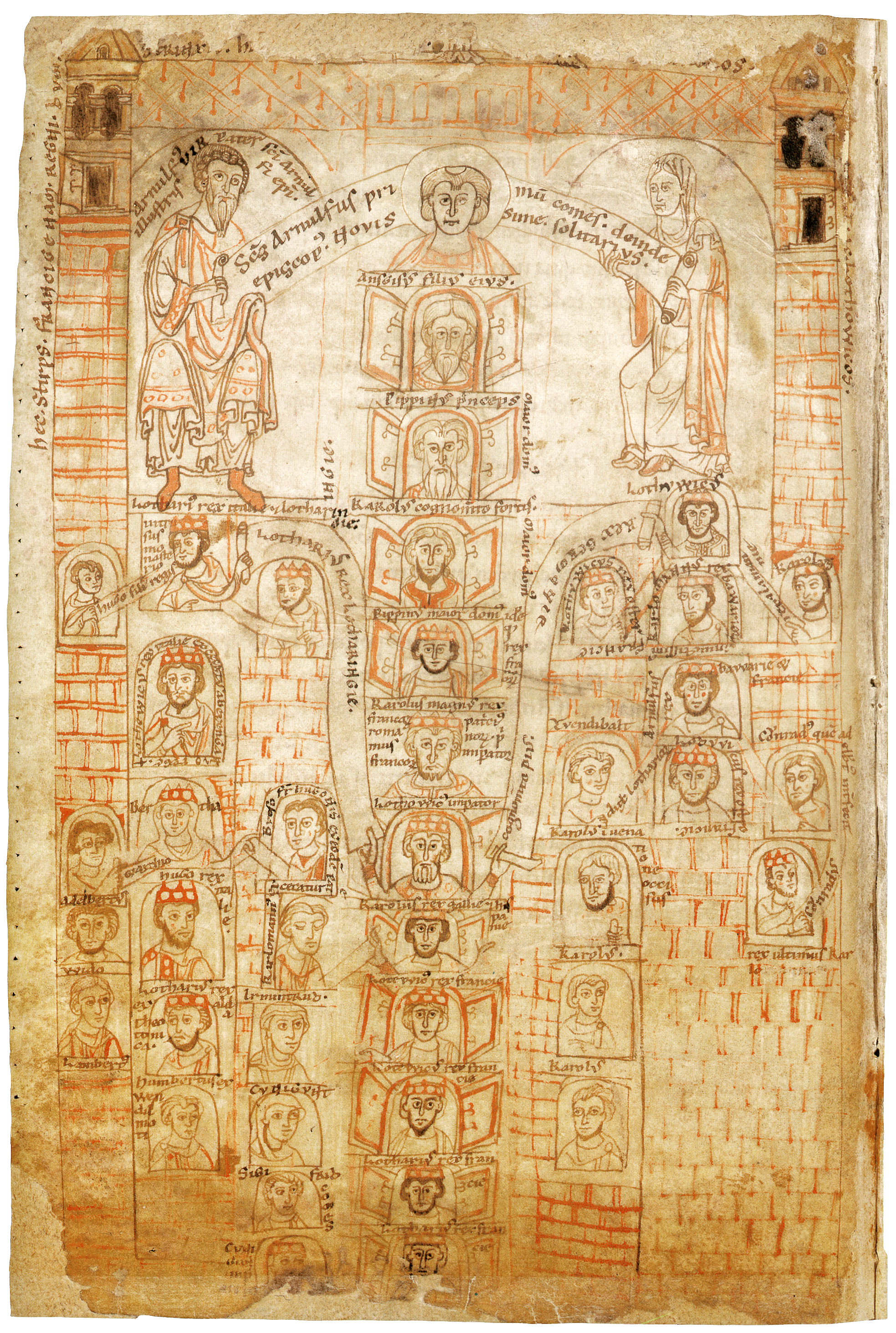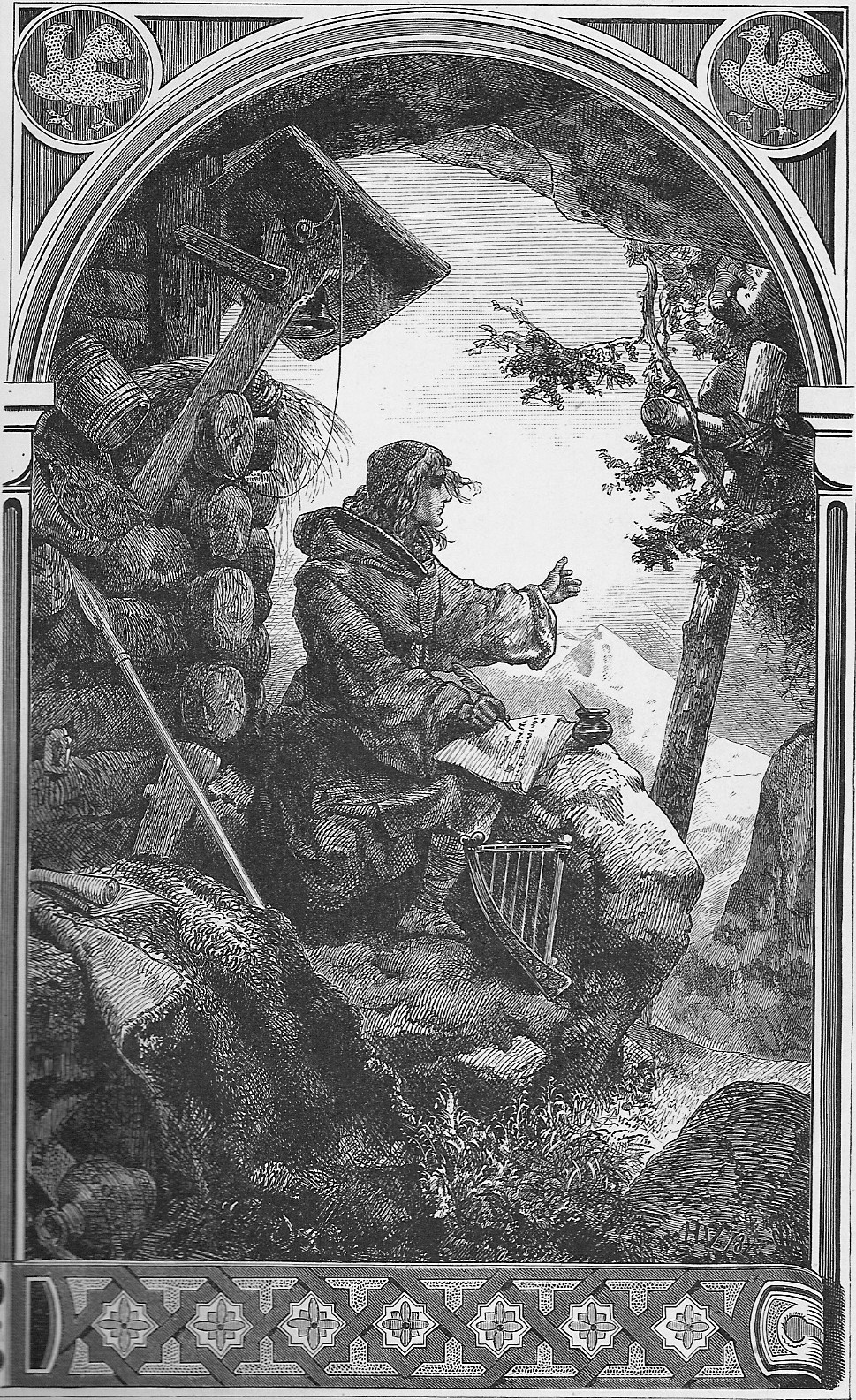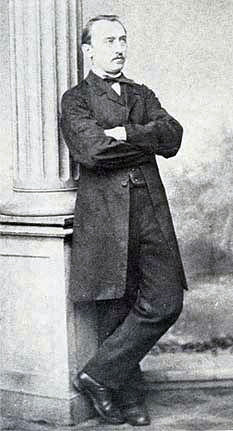|
Ekkehard
Ekkehard (and Eckardt, Eckard, Eckart, Eckhardt, Ekkehart) is a German given name. It is composed of the elements ''ekke'' "edge, blade; sword" and ''hart'' "brave; hardy". Variant forms include Eckard, Eckhard, Eckhart, Eckart. The Anglo-Saxon form of the name was ''Ecgheard'', possibly attested in the toponym Eggerton. Middle Ages It was the name of five monks of the Abbey of Saint Gall from the tenth to the thirteenth century: *Ekkehard I (died 973) * Ekkehard II (died 990) * Ekkehard III *Ekkehard IV (died c. 1056) *Ekkehard V (died c. 1220) It was also the name of two Margraves of Meissen: * Eckard I (died 1002) * Eckard II (died 1046) Other notable people with that given name include: *Ekkehard of Huysburg (died 1084), abbot of Huysburg Abbey *Ekkehard of Aura (died 1126), chronicler and abbot of Aura Abbey *Meister Eckhart (died c. 1327), philosopher and mystic *Eckhard Christian (1907-1985), Luftwaffe officer *Ekkehard von Kuenssberg (1913–2000), German doctor *Eckhar ... [...More Info...] [...Related Items...] OR: [Wikipedia] [Google] [Baidu] |
Ekkehard II
Ekkehard II (died 23 April 990), called ''Palatinus'' ("the Courtier"), was a monk of the Abbey of Saint Gall who became known for his sequence poetry. Life Ekkehard was probably born in the Saint Gall area; he and his cousin Ekkehard III were nephews of Ekkehard I (''Ekkehardus Decanus''; 910–973), dean at the abbey and presumed author of the ''Waltharius'' poem. Ekkehard II was educated by his uncle and the monk Geraldus, who educated also his other nephews, Notker Physicus and Burkard, later abbot of the monastery. Ekkehard II likewise became a teacher at the monastery school. A number of his pupils joined the order; others became bishops. About 973 Dowager Duchess Hadwig of Swabia, the widow of Duke Burchard III called Ekkehard II to her seat at Hohentwiel Castle. Hadwig, a member of the Imperial Ottonian dynasty, was wont occasionally to visit St. Gall, and eventually asked for and obtained the services of Ekkehard as her tutor in the reading of the Latin classics. Never ... [...More Info...] [...Related Items...] OR: [Wikipedia] [Google] [Baidu] |
Eckhard Christian
Ekkehard (and Eckardt, Eckard, Eckart, Eckhardt, Ekkehart) is a German given name. It is composed of the elements ''ekke'' "edge, blade; sword" and ''hart'' "brave; hardy". Variant forms include Eckard, Eckhard, Eckhart, Eckart. The Anglo-Saxon form of the name was ''Ecgheard'', possibly attested in the toponym Eggerton. Middle Ages It was the name of five monks of the Abbey of Saint Gall from the tenth to the thirteenth century: *Ekkehard I (died 973) * Ekkehard II (died 990) * Ekkehard III *Ekkehard IV (died c. 1056) *Ekkehard V (died c. 1220) It was also the name of two Margraves of Meissen: * Eckard I (died 1002) * Eckard II (died 1046) Other notable people with that given name include: *Ekkehard of Huysburg (died 1084), abbot of Huysburg Abbey *Ekkehard of Aura (died 1126), chronicler and abbot of Aura Abbey *Meister Eckhart (died c. 1327), philosopher and mystic *Eckhard Christian (1907-1985), Luftwaffe officer *Ekkehard von Kuenssberg (1913–2000), German doctor *Eckhar ... [...More Info...] [...Related Items...] OR: [Wikipedia] [Google] [Baidu] |
Ekkehard Of Aura
Ekkehard of Aura ( la, Ekkehardus Uraugiensis; died 1126) was the Abbot of Aura (a monastery founded by Otto, Bishop of Bamberg, on the Franconian Saale river, near Bad Kissingen, Bavaria) from 1108. A Benedictine monk and chronicler, he made updates to the ''World Chronicle'' (''Chronicon universale'') of Frutolf of Michelsberg, adding important German history between 1098 and 1125 during the reign of Emperor Henry V, in which he sided strongly with the papacy in the Investiture Controversy. He was a participant in the Crusade of 1101 (Lerner, 1989), and provided important source material for the Rhineland massacres of Jews and for the First Crusade. References Further reading *Ekkehard of Aura from the Catholic Encyclopedia *Albert of Aix and Ekkehard of Aura"Emico and the Slaughter of the Rhineland Jews"from the Internet Medieval Sourcebook *Ekkehard of AuraHierosolymita and World Chronicle (On the Crusades)from the Internet Medieval Sourcebook *Robert E. Lerner, "Ekkerhard ... [...More Info...] [...Related Items...] OR: [Wikipedia] [Google] [Baidu] |
Ekkehard I
Ekkehard I ( la, Eccehardus; died 14 January 973), called ''Major'' or ''Senex'' (the Elder), was a monk of the Abbey of Saint Gall. He was of noble birth, of the Jonschwyl family in Toggenburg, and was educated in the monastery of St. Gall; after joining the Benedictine Order, he was appointed director of the inner school there. Later, under Abbot Kralo, who trusted him implicitly, he was elected dean of the monastery, and for a while directed all the affairs of the abbey. Ekkehard made a pilgrimage to Rome, where he was retained for a time by Pope John XII, who presented him with various relics of St. John the Baptist. After Kralo's death Ekkehard refused the abbatial succession, because of lameness resulting from a fractured leg. However, he directed the choice of Burkard, son of Count Ulrich of Buchhorn, who governed St. Gall with the advice and co-operation of Ekkehard. The latter erected a hospice in front of the monastery for the sick and strangers, and was in many other ... [...More Info...] [...Related Items...] OR: [Wikipedia] [Google] [Baidu] |
Eckard II, Margrave Of Meissen
Eckard II (german: Ekkehard; – 24 January 1046) was Margrave of Lusatia (as Eckard I) from 1034 and Margrave of Meissen from 1038 until his death. He was the last of his dynasty, with his death the line of Ekkeharding margraves descending from Eckard I of Meissen (d. 1002) became extinct. Life He was a younger son of Margrave Eckard I of Meissen and his wife Swanehilde. Eckard was a count in the '' Gau'' Chutizi east of Merseburg as well as in the burgward of Teuchern. Upon the assassination of his father in 1002, Eckard II and his elder brother Herman I ruled over the Ekkeharding allodial lands, while the Meissen margravial title first passed to their uncle Gunzelin feuding with his nephews until his deposition in 1009. During the German–Polish War around the Lusatian and Milceni lands, the brothers were able to maintain the rule over the Meissen lands until fighting ended with the 1018 Peace of Bautzen. About 1026, Eckard married Uta von Ballenstedt, sister of the Saxo ... [...More Info...] [...Related Items...] OR: [Wikipedia] [Google] [Baidu] |
Ekkehard Of Huysburg
Blessed Ekkehard of Huysburg (died 28 June 1084) was a canon at Halberstadt Cathedral and first abbot of the Benedictine abbey in Huysburg. Life According to the chronicles of the Annalista Saxo, Ekkehard about 1070 was appointed by Bishop Burchard II of Halberstadt as the spiritual director of the anchorite Pia, a nun from Quedlinburg, who lived at the site of a former Carolingian fortress in the Huy hill range north of the Halberstadt walls. Ekkehard also induced Adelheid from Gandersheim and Ida from Quedlinburg to live with Pia in her hermitage. After a short time other men and women gathered there, and Ekkehard founded the double monastery (i.e., for both monks and nuns) of the Huysburg Huysburg (; german: Kloster Huysburg) is a Order of Saint Benedict, Benedictine monastery situated on the Huy (hills), Huy hill range near Halberstadt, in the Germany, German state of Saxony-Anhalt. The Romanesque architecture, Romanesque abbey has ... (''Huy Castle''), of which he was elec ... [...More Info...] [...Related Items...] OR: [Wikipedia] [Google] [Baidu] |
Ekkehard IV
Ekkehard IV ( 980 – c. 1056) was a monk of the Abbey of Saint Gall and the author of the ''Casus sancti Galli'' and ''Liber Benedictionum''. Life According to the testimony in his "Chronicle" (especially in view of his statement that he had heard from eyewitnesses of the great conflagration at St. Gall in 937), the date of his birth is usually placed about 980; he died 21 October but the year of his death is unknown (1036?–1060?). The same "Chronicle" indicates Alsace as his birthplace, though we do not know with certainty either the place of his birth, or his family origin. His boyhood was spent at St. Gall where he had for tutor Notker Labeo the German, one of the most learned scholars of his time. From him Ekkehard acquired a profound knowledge of the Latin and Greek classics; he also studied mathematics, astronomy, and music, and was acknowledged while living as a scholar of note even outside the monastery. After the death of Notker Labeo (1022), Ekkehard was called to Mainz ... [...More Info...] [...Related Items...] OR: [Wikipedia] [Google] [Baidu] |
Margraves Of Meissen
This article lists the margraves of Meissen, a march and territorial state on the eastern border of the Holy Roman Empire. History King Henry the Fowler, on his 928-29 campaign against the Slavic Glomacze tribes, had a fortress erected on a hill at Meissen (''Mišno'') on the Elbe river. Later named ''Albrechtsburg'', the castle about 965 became the seat of the Meissen margraves, installed by Emperor Otto I when the vast ''Marca Geronis'' (Gero's march) was partitioned into five new margraviates, including Meissen, the Saxon Eastern March, and also the Northern March which eventually became the Margraviate of Brandenburg. During the tenth century, the Meissen margraves temporarily extended their territory into the Milceni lands up to the Kwisa (''Queis'') river and the border with the Silesian region of the Early Polish state. The eastern lands around Bautzen (''Budissin''), later known as Upper Lusatia, were ceded to the Polish duke Bolesław I the Brave according to the 101 ... [...More Info...] [...Related Items...] OR: [Wikipedia] [Google] [Baidu] |
Ekkehard Von Kuenssberg
Ekkehard von Kuenssberg CBE (17 December 1913 – 27 December 2000), , was a German-born physician who made his career in Scotland. He was chairman and later president of the Royal College of General Practitioners and was appointed as its Wolfson Travelling Professor. Early life Kuenssberg was the son of Eberhard von Kuenssberg, a professor who taught law at the University of Heidelberg, and of Dr Katharina von Kuenssberg, a biologist.Alan Large"Ekkehard Von Kuenssberg Former general practitioner (b 1913; Edinburgh 1939; CBE, FRCP Ed, FRCOG, FRCGP), d 27 December 2001" ic bmj.com, accessed 29 January 2021 Kuenssberg’s German ancestry could be traced to the reign of Charlemagne."Dr Ekkehard Kuenssberg" '' The Herald'' (Glasgow), 6 January 2001, accessed 29 January 2021 His mother was the daughter of Gustav Samson, owner of a large cloth mill in Cottbus, and of his wife Anna Goldschmidt, whose family was of Jewish origins. He was educated at Schloss Salem, Baden, under the h ... [...More Info...] [...Related Items...] OR: [Wikipedia] [Google] [Baidu] |
Johann Joseph Abert
Johann Joseph Abert (20 September 1832 – 1 April 1915 in Stuttgart) was a German composer. An ethnic German from the Sudetenland, he is also known in Czech as Jan Josef Abert. Life and career Abert was born in Kochowitz near Gastorf, Bohemia, now Kochovice, Hoštka, Czech Republic. He studied double bass at the Prague Conservatory with Josef Hrabě and also received lessons in theory from Johann Friedrich Kittl and August Wilhelm Ambros. In 1853, Peter Josef von Lindpaintner selected him as a double bassist for the Court Orchestra at Stuttgart, the royal capital of Württemberg. He became the Court Kapellmeister in 1867 and remained in this office, previously occupied by Lindpainter, Friedrich Wilhelm Kücken, and Karl Anton Eckerts, until 1888. Abert composed chamber music and ''lieder,'' as well as several successful operas. Of his seven symphonies, the ''Frühlingssinfonie'' (''Spring Symphony'', No. 7) in C, the program symphony ''Columbus'' (No. 4), and the ''Symphony in ... [...More Info...] [...Related Items...] OR: [Wikipedia] [Google] [Baidu] |
Eckard I, Margrave Of Meissen
Eckard I (''Ekkehard'';Rarely ''Ekkard'' or ''Eckhard''. Contemporary Latin variants to his name include ''Ekkihardus'', ''Eggihardus'', ''Eggihartus'', ''Heckihardus'', ''Egihhartus'', and ''Ekgihardus''. – 30 April 1002) was Margrave of Meissen from 985 until his death. He was the first margrave of the ''Ekkehardinger'' family that ruled over Meissen until the extinction of the line in 1046. Life Eckard was of noble east Thuringian stock, the eldest son of Margrave Gunther of Merseburg (d. 982). He followed his father into exile from 976 to 979 and took part in the 982 Battle of Stilo against the Emirate of Sicily, where Gunther was killed. Back in Germany, Eckard upon the death of Emperor Otto II in 983 supported his minor son King Otto III of Germany. At the ''Hoftag'' diet of Rohr in June 984, he together with Archbishop Willigis of Mainz and several German princes enforced the release of the four-year-old king by his rivaling cousin Duke Henry II of Bavaria. In 985 Ot ... [...More Info...] [...Related Items...] OR: [Wikipedia] [Google] [Baidu] |
Ekkehard III
Ekkehard III was a monk of the Abbey of Saint Gall and a nephew of Ekkehard I Ekkehard I ( la, Eccehardus; died 14 January 973), called ''Major'' or ''Senex'' (the Elder), was a monk of the Abbey of Saint Gall. He was of noble birth, of the Jonschwyl family in Toggenburg, and was educated in the monastery of St. Gall; afte ... and a cousin of Ekkehard II. He shared the educational advantages of his cousin and, at his invitation, accompanied him to Hohentwiel to superintend and direct the studies of the local clergy. On his return to St. Gall he was made dean of the abbey, and is reported to have filled this office for thirty years. He died early in the eleventh century. Sources *{{CathEncy, url=http://www.newadvent.org/cathen/05370a.htm, title=Ekkehard Monks at Saint Gall ... [...More Info...] [...Related Items...] OR: [Wikipedia] [Google] [Baidu] |



